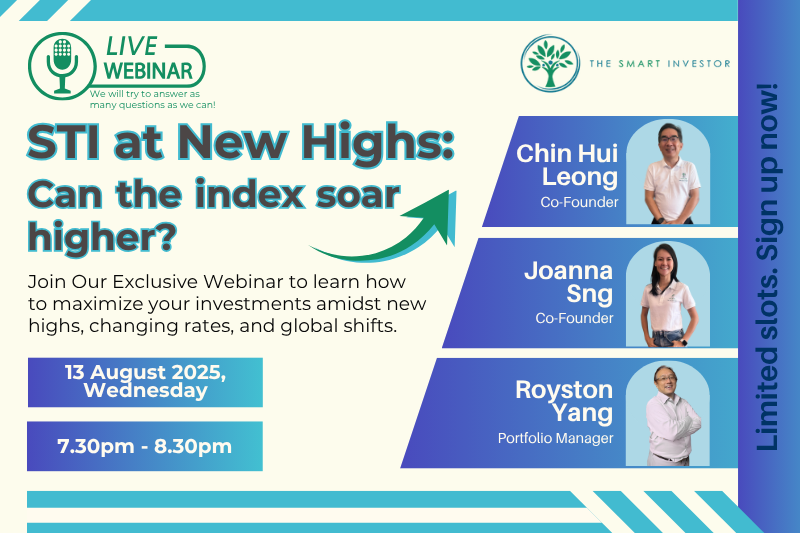Most investors will talk about their winners but not their losers.
Even the best investors make mistakes.
Take Warren Buffett, for example. Widely regarded as one of the greatest, he’s openly admitted to his share of investment errors.
So, what constitutes a mistake?
In my view, it’s when a stock you’ve held for five years or more and still yields a negative total return after factoring in dividends.
That means you’ve lost money, even if you’ve reinvested all the dividends you received over that time.
But why five years?
It’s a long enough time frame for a business to demonstrate substantial growth in revenue and profits.
What do you do if you made a mistake?
For starters, it is important to remain composed.
Mistakes serve not only to refine your investment skills but also to impart valuable lessons on how you can do better in the future..
Refining your criteria
If you find yourself consistently buying the wrong stocks , it is high time for you to consider looking at your investment criteria.
When I first started investing back in 2005, I purchased shares of hot favourites such as Ezra Holdings and Swiber Holdings.
The oil and gas industry was booming.
With the wind on their backs, it felt like a sure bet for the shares to skyrocket in value.
Little did I know that both companies were on a debt-fuelled growth binge that was bound to backfire.
For the record, Swiber filed for liquidation in July 2016 after incurring hundreds of millions of dollars in debt while Ezra Holdings filed for bankruptcy protection in the US a year later in 2017.
Thankfully, I came to my senses and sold before the carnage.
Although I escaped unscathed, those missteps taught me to look for companies with steady free cash flow in my investment journey.
In essence, I’ve grown as an investor, thanks to the lessons learned from those early blunders.
It’s important to flip the script.
Rather than beating yourself up over mistakes, embrace them as invaluable learning opportunities.
Unknown unknowns
Mistakes can stem from factors beyond our control.
Life’s full of surprises, influenced by countless unpredictable events.
Similarly, in investing, brace yourself for unforeseen circumstances that may disrupt your original strategy.
Even if you are thorough with your risk analysis, there are “unknown unknowns” that can emerge unexpectedly.
Think of natural disasters such as earthquakes, tsunamis, or the recent COVID-19 pandemic.
Beyond nature’s curveballs, technological leaps can also upend your investment assumptions.
Imagine a new product stealing the spotlight, rendering its predecessor obsolete overnight.
If you’ve invested in the older version of this product, expect a sharp downturn in sales and profits.
Such events are inherent risks in investing, impossible to completely foresee.
No matter how diligent your research is, there’s always a chance of an unforeseen setback.
These surprises are tricky to mitigate and often catch you off guard.
Don’t be too hard on yourself
Curious about an acceptable error rate? Just consult Peter Lynch.
The former manager of Fidelity’s Magellan Fund boasted an impressive 13-year run, averaging a stunning 29% annual return, outperforming the S&P 500 Index nearly every year.
According to Lynch, aiming for a 90% success rate is close to impossible.
In his view, you are considered a good investor if you can get six out of 10 investments right.
So, if a seasoned fund manager like Lynch suggests that a 60% accuracy rate is respectable, investors shouldn’t dwell too much on occasional slip-ups.
Errors are not just inevitable; they’re evidence that perfection is unattainable.
The key?
Ease up on yourself when mistakes happen and assess their impact on your portfolio.
Why?
Because not all mistakes carry the same financial weight.
Losing 90% on a $1,000 investment hurts, but it’s manageable. However, a 10% loss on a $100,000 position means a $10,000 hit.
This example highlights that the percentage of loss isn’t everything. What matters more is the actual dollar amount at stake.
And this calculation ties directly to how much capital you allocate to each position in your portfolio.
Winning big, losing small
Imagine you have a straightforward portfolio: 10 positions, each with a S$1,000 investment, totalling S$10,000.
Over five years, one stock plunges by 90%, while another skyrockets tenfold from its original price.
Applying Lynch’s 60% winning ratio, let’s say another five stocks enjoy a 20% increase while three dip by roughly 20%.
Crunch the numbers, and you’ll find the four losers now amount to S$2,500 (that’s S$100 plus S$2,400), representing a 37.5% drop from their starting value of S$4,000 (four stocks times S$1,000).
On the winning side, the six stocks tally up to S$16,000 (that’s S$10,000 plus S$6,000), soaring almost 167% above their initial S$6,000.
Check out the table below for a clear breakdown of this scenario.
Source: Author’s Calculations
Even with four stocks in the red, your portfolio still boasts an impressive 85% overall gain after five years.
That translates to an impressive compound annual growth rate (CAGR) of 13.1%.
This example vividly demonstrates how your capital allocation decisions impact your investment returns.
If you had confidently identified a potential winner and allocated a larger portion of your capital to it, your winners would have outweighed your losers by a significant margin.
By sizing your positions based on a favourable risk-reward ratio, you ensure big wins and minimal losses.
Keep in mind: while a stock’s price can soar indefinitely with rising profits, your potential loss is capped at 100%.
This fundamental truth works in your favour: allowing your successful investments to flourish over years or even decades can easily offset any occasional missteps.
Get Smart: Don’t be afraid to make mistakes
Investing without making mistakes is like trying to surf the ocean waves without getting wet—it’s just not realistic.
Instead of dreading errors, embrace them as valuable lessons that mould you into a savvier investor.
An alternative is to avoid investing altogether and to park all your money in a capital-guaranteed fixed deposit or bank account.
However, this option is almost guaranteed to lose you money through inflation.
Acknowledge that mistakes are par for the course, all the while fine-tuning your investment strategy.
Make sure these missteps amount to mere hiccups while allowing your successful investments to snowball into substantial profits.
This approach not only hones your investing prowess but also delivers commendable results over time.
Note: An earlier version of this article appeared in The Business Times.
Our beginner’s guide to investing is finally here! Many investors took years to understand the principles inside, but you can have it all in one afternoon. If you have just started investing, download our free guide today so you can catch up quickly. Click here to download now.
Follow us on Facebook and Telegram for the latest investing news and analyses!
Disclosure: Royston Yang does not own shares in any of the companies mentioned.






